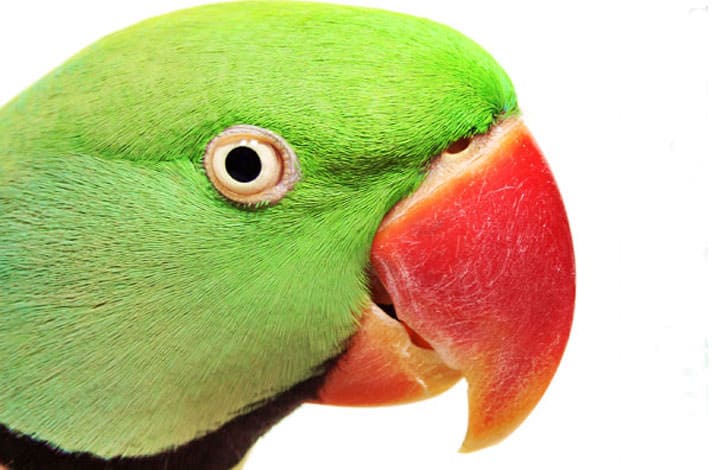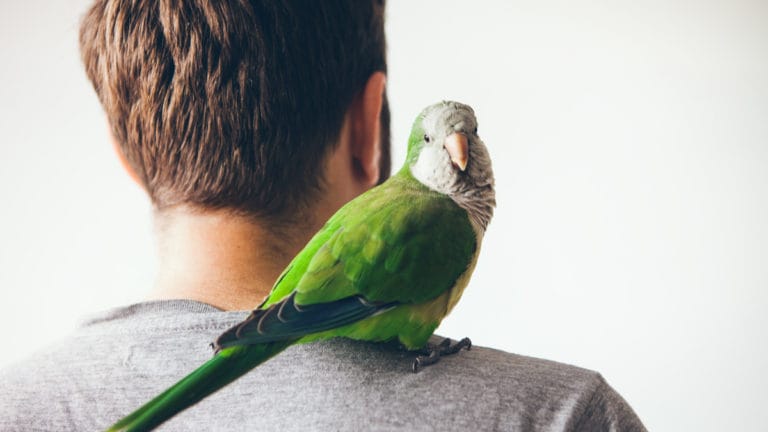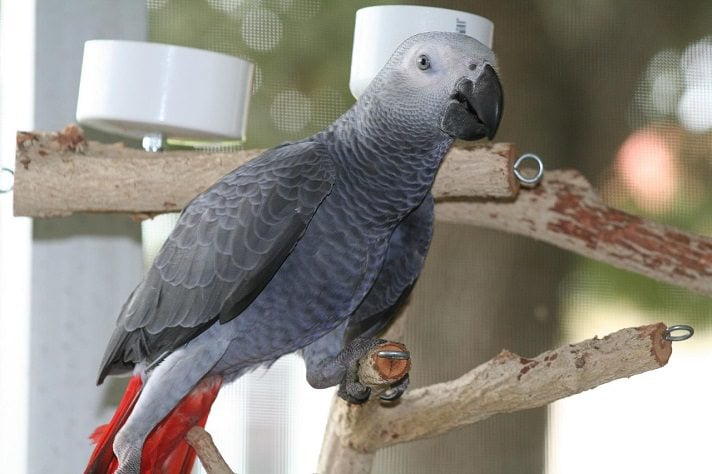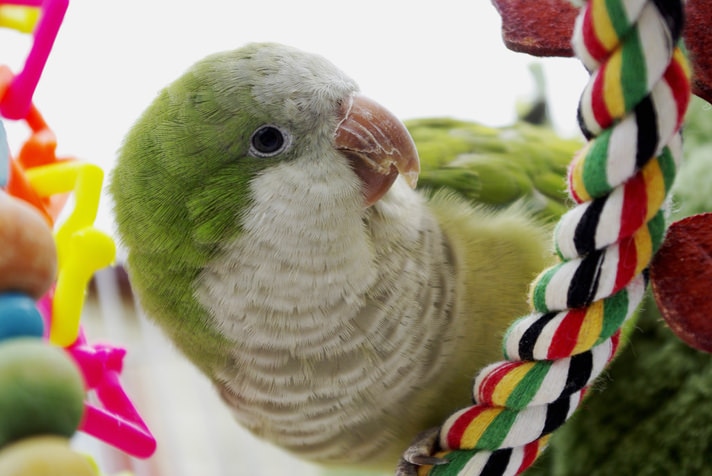About 40 million years ago, during the Eocene Epoch and long before man walked the Earth, the first parrot-type birds lived in the areas we now know as England, Austria and Germany. With no people to draw their likeness or write about their captivating ways, the only way we know that parrots existed is through fossilized remains. Some of the most important pieces of the puzzle were the bones of the foot, identifying the bird as zygodactylous, with the inner two toes facing forward and the two outer toes facing back. This is a characteristic parrots share with only a few other species, such as woodpeckers and cuckoos.
Climate changes likely sent early parrot species flying off to seek hospitable areas, as they are no longer indigenous to Europe. The shifting and separating of continents may have isolated populations and entire species. Parrots are relatively new to Africa and South America, dated as appearing in Africa between 1.5 and 7 million years ago, and in South America approximately 1.5 million years ago. The greatest population of parrot species now lives in South America. A 16- to 20-million-year-old (depending on source) fossil bone found in Nebraska was determined to be related to the extinct Carolina parakeet.
Of the approximately 330 parrot species, the Carolina parakeet was the only parrot native to eastern North America. At one time, it flourished in Florida, South Carolina and Louisiana with its range extending north as far as New York and North Dakota and west to Nebraska. One of the last confirmed sightings of wild Carolina parakeets was reported in 1904, with unverified sightings occurring until 1944. Reasons for its extinction include hunting, loss of habitat and nesting locations, as well as possible avian diseases imported with European settlers. The last captive bird died at the Cincinnati Zoo in 1918.
The Parrot’s Long History
People have been entranced by parrots for thousands of years. Cave paintings of macaws in Brazil have been dated to 5,000 years ago. Parrots, canaries and other birds have been revered as beloved pets, lauded as status symbols, depicted in art and literature, showcased in zoos and had their likeness displayed as decorations.
Egyptians were likely the first to keep African grey parrots as pets. The first written reference to parrots was found in the “Rig-veda” Indian literature written more than 3,000 years ago. By the third century A.D., Chinese poetry described birds in cages and birds were housed in cages trimmed with jewels. Chinese culture is still very bird-oriented, and people travel everywhere with their little singing finches, bringing them along in small carrying cages. The “Kama Sutra (10th to 13th century A.D.) stated that one of the 64 requirements of a man was to teach a parrot to talk. Parrots were considered “birds of love” in ancient India and were also the subjects of satire and fables.
During the first millennium B.C., parrots were kept as companions to royalty and the upper classes in Asia and Africa. Parrots first appeared in Europe in 327 B.C., when Alexander the Great’s forces conquered India and took ring-necked parrots back home to Greece. (The Alexandrine parakeet was named for him.) During this period, cages were fashioned of precious metals and embellished with ivory and tortoiseshell, as befitting the magnificent creatures inside.
As the Roman Empire came to prominence, talking parrots, apparently Psittacula parrots from India, were all the rage among the upper classes, professional parrot teachers were employed to teach the birds to speak Latin. Early writings (Pliny the Elder, 77 A.D.) contained instructions for teaching parrots to talk by hitting them on the head with iron bars.
As the Roman Empire declined in the fifth century, A.D., so did interest in parrots. Curiosity was piqued again during the Middle Ages, when crusaders, merchants and explorers returned home with their feathered treasures. At this time, birds were generally owned by the wealthy and housed in ornamental cages.
Henry VIII shared Hampton Court with a much-loved African grey parrot during the 16th century. Charles V owned bird cages embellished with gemstones. Birds and cages were so popular that France had a cage-makers guild, an organization of craftsmen dedicated to fashioning fine bird homes. Although cages from this period did not survive through the centuries, some are depicted in art from the era.
Marco Polo reported sighting a variety of parrots in the coastal areas of southern India during his 13th century explorations. The Portuguese controlled part of the West African coast in the mid 1400s and frequently brought African grey parrots back home with them. Talking parrots were so highly regarded by the Church at this time that Pope Martin V appointed a “Keeper of the Parrots” to ensure their care. Talking parrots were also mentioned in Chaucer’s “Canterbury Tales.”
It is believed that a flock of parrots led Christopher Columbus off course in 1492. He made landfall in the Caribbean, where he was presented with what were likely Cuban Amazons in exchange for the gifts he gave the natives. He brought a pair of parrots back to Queen Isabella when he returned to Spain, thus promoting a resurgence of interest in the exotic creatures. Further exploration took Columbus to Guadeloupe and Trinidad where he was the first European to see macaws. Several years later, the Portuguese arrived in Brazil, which they called Terra de Papagaios, which translated, means “Land of the Parrots.” In the 1500s, Magellan’s crew reported on the cockatoos they’d seen in their travels, and mapmaker Gerard Mercator designated an area, probably Australia, as Psitacorum Regio, “Region of the Parrots.” If Lewis and Clark saw parrots as they traversed the United States, they were probably Carolina parakeets.
The 18th century brought the Age of Enlightenment, and its more aesthetic values. Louis XV and Louis XVI commissioned elaborate bird cages and aviaries for the gardens at Versailles. The cages were so decorative and embellished that the birds inside were only incidental. Elaborate cages were de rigueur in wealthy European homes during the 18th century. Some cages were purely decorative and not intended as avian residences.
During the 1800s, budgerigars (budgies) were introduced to England, and middle-class English families were captivated by these friendly and colorful new pets. They housed them in large, intricate cages replicating existing buildings, such as the Taj Majal and the Crystal Palace. In the United States, 19th-century cages were often fanciful reproductions of ships and notable architecture. According to an article in the “New York Times” (dated 10/3/03), English architect Jacob Wrey Mould designed a series of intricate birdcages for Central Park in 1862. Only one of these was actually built, but it no longer stands in the park.
The Hendryx Company began manufacturing bird cages in the United States in 1869. The brand is still viable today, as Prevue Pet Products’s Prevue Hendryx line. Parrots’ feathers and even their preserved bodies decorated ladies’ hats during the 1800s, a sight that would be met with horror today.
Parrot History: The 1900s
The Great Depression, the “parrot fever” scare of 1929 to 1930 and World War II all took a toll on the exotic bird hobby. The Hendryx Company interrupted its cage manufacturing to participate in the war effort.
Large birds were not common household pets, but canaries were popular in the United States during the first half of the 20th century. The American Radio Warblers, billed as “canary songsters” were featured on live radio broadcasts during the late 1930s until about 1952. The birds sang along with background music, and some of the recordings still exist on 78-RPM records. Budgies became extremely popular in the 1940s and 1950s.
The 1970s saw a resurgence in parrot ownership, which some attribute to the popularity of Fred, the cockatoo in the hit television series, “Baretta.” During this decade pet shops also began displaying tame parrots on open stands, which encouraged people to interact more closely with the larger birds. Many of these parrots had been imported as youngsters and tamed and trained by the store owners, who used positive-reinforcement methods rather than fear and intimidation, thus making the birds better potential pets.
As interest in exotic birds surged, better cages and avian diets entered the market. Bird toys, long a staple item for budgies, began to appear for larger hookbills. Bird breeders, as conservation legislation loomed, began to intensify their captive-breeding efforts.
With increasing demand, avian medicine became a specialty and the Association of Avian Veterinarians was established in 1980. Two years later, BIRD TALK Magazine began publishing, bringing timely information to information-hungry bird hobbyists. As a result of published research, people became aware that fumes from heated nonstick cookware can be deadly to birds. In 1986, New York enacted a law prohibiting the trade of imported exotic birds within the state, and the World Parrot Trust was established in 1989. Irene Pepperberg’s research with African grey Alex gained prominence, as she proved that birds can distinguish differences between objects and communicate cognizantly.
The rigid, angled cage apron revolutionized large cage design in the 1980s, although it had been previously used on small Prevue cages around the turn of the century. Intended to direct cage fallout back into the bottom tray, this design feature has become almost standard equipment on many bird cages manufactured today.
The Wild Bird Conservation Act of 1992 (see below) halted most imports of exotic birds into the United States. In 1993, the American Board of Veterinary Practitioners began offering board certification in avian medicine and surgery.
Parrot History: Today
Many bird breeders now specialize in breeding several species rather than the general avian breeding efforts of the 70s and 80s. According to African parrot breeder Jean Pattison of Florida, the old breeding stock is retiring as are many of the people in the business. Fewer young people seem interested in taking over or starting breeding businesses and, depending on species, former pets may not always make good breeding stock. In Pattison’s opinion, the number of available birds will decrease in years to come.
Parrot shelters and sanctuaries have been established to care for displaced pet birds. Death, disability, birth of a child, lifestyle changes, impulse purchases and over-adding to the flock by novice bird fanciers are some of the reasons avian shelters have become necessary, and in some cases, overwhelmed.
New Parrot Discoveries
Parrots are still being discovered. In 1980, a group of scientists came upon a previously unseen parrot in a cloud forest in El Oro, Ecuador. After studies were done to authenticate that it was indeed a new species, it was named the El Oro parakeet (Pyrrhura orcesi) in 1988. The Camiguin hanging parrot (Loriculus camiguinensis) of the Phillippines was recognized as a distinct species in 2006.
Bird Clubs Take Flight
Bird clubs first began as groups of bird breeders meeting to discuss avian husbandry and to show their birds in exhibitions. The Avicultural Society of America (ASA), founded in 1927, is perhaps the oldest U.S. organization still in existence. Another venerable organization, the Alamo Exhibition Bird Club in Texas, will celebrate its 40th anniversary in 2011.
Over the years, bird clubs gradually expanded to include pet owners. Captive bird-breeding efforts were the focus for many years. Eventually, the clubs took up various causes, such as conservation and avian medical research, and raised money to support those efforts. Presently, education is at the forefront, with bird clubs attempting to inform the public about avian behavior and the proper care of their birds.
Many clubs are also involved in adoption and rehoming efforts as a service to members and local residents who can no longer keep their pet birds.
Today, national and international organizations, such as the American Federation of Aviculture, (AFA), the World Parrot Trust (WPT) and Parrots International support worldwide education and conservation efforts.
Posted by: Chewy Editorial
Featured Image: Via Gina Cioli/Lumina Media
Share:









